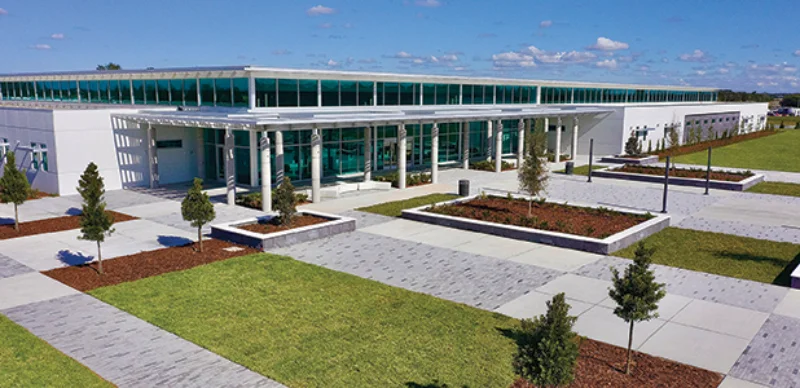Structural lightning protection
Structural lightning protection (lightning rods), grounding, bonding, and surge protection are all important factors when considering the development of a reliable lightning protection system. However, as modern processes become more reliant on electronic automation and electrical equipment to increase productivity, advances in surge protection design have provided what has become the most critical element to any successful equipment lightning protection system. Lightning strikes and the dangerous surges and transients induced by lightning, as well as surges caused by switching and regulation problems, can lead to catastrophic equipment losses, operational downtime, production and revenue losses, and ultimately will lead to significantly increased equipment repair and electrical maintenance costs. During a lightning strike, voltage differences of tens of thousands of volts can arise between different parts of even the best grounding network. If the connecting wires do not pass through a Surge Protection Device (SPD), then the voltage differences are carried directly into the equipment, and can cause severe damage.
Peak Surge Current Ratings
The Peak Surge Current rating is normally the largest single surge current (kA) that a device can withstand without damage. This rating should exceed the largest single surge that the SPD would experience in its lifetime. Installations in high-lightning areas should use an SPD with a higher surge current rating, in the range of 50 kA (50,000 amps) to 200 kA (200,000 amps), in order to provide a longer service life and higher reliability.
Many manufacturers publish Peak Surge Current ratings that are aggregate totals of individual components within the SPD. Actual peak performance may be only a fraction of this total. Many SPD comparisons begin with the peak surge rating and we have found that this can sometimes be very misleading information. For example, published Peak Surge Current Ratings in excess of 200,000 amps were not ever tested to these levels. The average lightning strike will vary from 20,000 to 50,000 amps. Extreme lightning strikes may exceed 100,000 amps. SPD ratings that exceed 100,000 amps are usually the sum total of the parts in the device and while the higher peak rating numbers will provide more durability, any event that exceeds the weakest link of the device will still cause it to fail.
Over-current Protection
Circuit breakers, fuses, and relays are not fast enough to protect sensitive electronic and electrical equipment from damage due to lightning surges. However, to reduce the severity of the SPD damage in overload situations and to protect from the risk of fire, and to protect the integrity of the power distribution system, the AC power SPD should be installed with the appropriate over-current protection (circuit breaker or fuses). It is very important that some means of disconnection to the power be close by the installed SPD to safely service the device.
Temporary Over-voltage (TOV)
Short term (swells) and longer-term Temporary over-voltage (TOV) conditions can lead to rapid degradation and even complete failure of SPD components. This (not lightning) is the leading cause of SPD failure. TOVs are typically the result of loose or open neutral conductors, voltage regulator problems, or the inadvertent contact of higher voltage to the system. If the TOV voltage exceeds the Maximum Continuous Operating Voltage rating (MCOV) of the SPD, the Device will attempt to suppress the over-voltage and will begin to conduct current. This can lead to significant component level over heating and eventual destruction of the SPD.
Patented frequency based power suppressors have circuitry that allows them to combine a very low surge limiting voltage (let through voltage) with the capability to withstand TOVs. They are not as vulnerable to most open-neutral faults and subsequently survive in the field for a significantly longer operating life while protecting at the lowest possible clamping levels.
Other Factors, Myths, and Misrepresentations
The installation of lightning rods will not protect electrical and electronic equipment from surges and lightning damage. Lightning rods sole function is to protect buildings from structural damage and potential fire as a result of a direct strike.
Surge Protective Devices are incapable of saving energy. Conclusive testing has determined that the claims by some manufacturers of saving power with the addition of an SPD to your power panels are complete misrepresentations.
SPD warranty claims that involve connected load guarantees are extremely conditional and virtually impossible to collect. The fine print of the connected load guarantee usually specifies that the burden of proof is on the consumer that all circuits have been properly protected and grounded and, in addition, that the SPD was damaged during and not prior to the event. Connected load guarantees are marketing driven and much like extended warranties, are not designed to benefit the consumer.
When SPD protection is added to an operation that has been unprotected for any length of time, there will already be existing damage to processors, circuit boards, wiring insulation, and connections that took place prior to the installation of the SPD. The SPD will not ‘heal’ this damage and losses may continue for some time while the damaged equipment cycles out.
SPD product warranties that exceed five or even ten years (ie: 20 years to lifetime) are marketing tools that fail to recognize the normal life expectancy of the components within the SPD. Lifetime and long term warranties generally do not accurately reflect SPD durability or performance capabilities. By their very nature, the SPD is a sacrificial device designed to take excess energy to protect your equipment.
Due to the difficulty in comparing Joule ratings, many companies no longer publish this number. Most standards written recently in the surge protection industry either warn of the possible misuse of Joule ratings or, by omission, do not recommend the use of Joule ratings when comparing an SPD.

